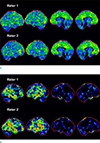1. Jack CR Jr. Alzheimer disease: new concepts on its neurobiology and the clinical role imaging will play. Radiology. 2012; 263:344–361.
2. Jack CR Jr, Petersen RC, O'Brien PC, Tangalos EG. MR-based hippocampal volumetry in the diagnosis of Alzheimer's disease. Neurology. 1992; 42:183–188.
3. Vermersch P, Leys D, Scheltens P, Barkhof F. Visual rating of hippocampal atrophy: correlation with volumetry. J Neurol Neurosurg Psychiatry. 1994; 57:1015.
4. Ashburner J, Friston KJ. Voxel-based morphometry--the methods. Neuroimage. 2000; 11:805–821.
5. Fischl B, Dale AM. Measuring the thickness of the human cerebral cortex from magnetic resonance images. Proc Natl Acad Sci U S A. 2000; 97:11050–11055.
6. MacDonald D, Kabani N, Avis D, Evans AC. Automated 3-D extraction of inner and outer surfaces of cerebral cortex from MRI. Neuroimage. 2000; 12:340–356.
7. Fischl B. FreeSurfer. Neuroimage. 2012; 62:774–781.
8. Lin Z, Avinash G, McMillan K, Yan L, Sirohey S, Minoshima S. Quantitative measurement of MR cortical atrophy: MR brain surface intensity model (BSIM) and group and individual cortical thinning studies. In : Proc SPIE 8672, Medical Imaging 2013: Biomedical applications in molecular, structural and functional imaging, 86720E; March 29, 2013.
9. Lin ZS, Avinash G, Yan L, McMillan K. Cortical thinning in cognitively normal elderly cohort of 60 to 89 year old from AIBL database and vulnerable brain areas. In : Proc SPIE 9038, Medical Imaging 2014: Biomedical applications in molecular, structural and functional imaging, 90381P; March 13, 2014.
10. Lee JS, Lee DS, Kim J, et al. Development of Korean standard brain templates. J Korean Med Sci. 2005; 20:483–488.
11. Tang Y, Hojatkashani C, Dinov ID, et al. The construction of a Chinese MRI brain atlas: a morphometric comparison study between Chinese and Caucasian cohorts. Neuroimage. 2010; 51:33–41.
12. Chee MW, Zheng H, Goh JO, Park D, Sutton BP. Brain structure in young and old East Asians and Westerners: comparisons of structural volume and cortical thickness. J Cogn Neurosci. 2011; 23:1065–1079.
13. McGraw KO WS. Forming inferences about some intraclass correlation coefficients. Psychol Methods. 1996; 1:30–46.
14. Shrout PE, Fleiss JL. Intraclass correlations: uses in assessing rater reliability. Psychol Bull. 1979; 86:420–428.
15. Fleiss JL. Statistical Methods for Rates and Proportions. 2nd ed. New York, NY: Wiley, John and Sons, Incorporated;1981.
16. Cicchetti DV, Sparrow SA. Developing criteria for establishing interrater reliability of specific items: applications to assessment of adaptive behavior. Am J Ment Defic. 1981; 86:127–137.
17. Maezawa M, Seki T, Imura S, Akiyama K, Takikawa I, Yuasa Y. Magnetic resonance signal intensity ratio of gray/white matter in children. Quantitative assessment in developing brain. Brain Dev. 1993; 15:198–204.
18. Narr KL, Bilder RM, Toga AW, et al. Mapping cortical thickness and gray matter concentration in first episode schizophrenia. Cereb Cortex. 2005; 15:708–719.
19. Lerch JP, Pruessner J, Zijdenbos AP, et al. Automated cortical thickness measurements from MRI can accurately separate Alzheimer's patients from normal elderly controls. Neurobiol Aging. 2008; 29:23–30.
20. Du AT, Schuff N, Kramer JH, et al. Different regional patterns of cortical thinning in Alzheimer's disease and frontotemporal dementia. Brain. 2007; 130:1159–1116.
21. Hartikainen P, Rasanen J, Julkunen V, et al. Cortical thickness in frontotemporal dementia, mild cognitive impairment, and Alzheimer's disease. J Alzheimers Dis. 2012; 30:857–874.
22. Lehmann M, Rohrer JD, Clarkson MJ, et al. Reduced cortical thickness in the posterior cingulate gyrus is characteristic of both typical and atypical Alzheimer's disease. J Alzheimers Dis. 2010; 20:587–598.
23. Ballmaier M, O'Brien JT, Burton EJ, et al. Comparing gray matter loss profiles between dementia
with Lewy bodies and Alzheimer's disease using cortical pattern matching:
diagnosis and gender effects. Neuroimage. 2004; 23:325–335.
24. Jubault T, Gagnon JF, Karama S, et al. Patterns of cortical thickness and surface area in early Parkinson's disease. Neuroimage. 2011; 55:462–467.
25. Li Y, Wang Y, Wu G, et al. Discriminant analysis of longitudinal cortical thickness changes in Alzheimer's disease using dynamic and network features. Neurobiol Aging. 2012; 33:427e415–e430.
26. Thompson PM, Hayashi KM, Dutton RA, et al. Tracking Alzheimer's disease. Ann N Y Acad Sci. 2007; 1097:183–214.
27. Iscan Z, Jin TB, Kendrick A, et al. Test-retest reliability of freesurfer measurements within and between sites: Effects of visual approval process. Hum Brain Mapp. 2015; 36:3472–3485.
28. Clarkson MJ, Cardoso MJ, Ridgway GR, et al. A comparison of voxel and surface based cortical thickness estimation methods. Neuroimage. 2011; 57:856–865.
29. Wyman BT, Harvey DJ, Crawford K, et al. Standardization of analysis sets for reporting results from ADNI MRI data. Alzheimers Dement. 2013; 9:332–337.
30. Jack CR Jr, Bernstein MA, Fox NC, et al. The Alzheimer's Disease Neuroimaging Initiative (ADNI): MRI methods. J Magn Reson Imaging. 2008; 27:685–691.










 PDF
PDF ePub
ePub Citation
Citation Print
Print


 XML Download
XML Download